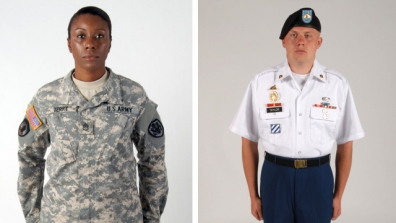Soldiers working in the Pentagon are swapping their combat fatigues (left) for what they call their service uniform / Army photos
First, the Army ditches the black beret for most soldiers at most times. Now it’s abandoning the wearing of combat fatigues inside the Pentagon. “Is it bad that this excites me more than the death of Bin Laden?” one soldier, apparently from Fort Drum, N.Y., writes on an Army Facebook page. “Kidding…Kind of.”
A decade after 9/11, it’s about time. In the horrible wake of 9/11, when the Pentagon itself was attacked by a hijacked airliner — killing 184 — the move to combat fatigues made some sense. But as the years passed, the phalanx of uniformed troops inside the Pentagon — never mind the Washington subway — seemed to become just a tad dated.
Soldiers pushed for the change, according to Sergeant Major of the Army Raymond F. Chandler III, who was ordered by the new Army chief of staff, General Martin Dempsey, to see how the grunts felt about what they were wearing. “I am a scout for General Dempsey, who asked me to look into everything a soldier wears from the top of his head to the bottom of his feet,” Chandler said. Scrapping the beret except for special occasions in favor of the standard patrol cap will save taxpayers $6.5 million every time it buys new uniforms for its troops because only one beret — not two — will be included.
“Our perspective is that this is the corporate part of the Army,” Chandler added. “The business-part of the Army is done in the Pentagon, and as a professional there are certain standards of attire associated with certain activities. For the business aspect of the Army, it is the Army service uniform.”
While outsiders might note the new headgear and uniforms, what’s really got the troops jazzed is a change allowing them to sew on name tapes, service tapes, rank insignia and skill badges, instead of using Velcro. “It sticks to everything in the wash,” writes one Army wife of her husband’s current uniform. “It drives him crazy trying to make sure everything is on straight.”
The Army makes clear why soldiers are happy with the change:
The Army’s new policy on attaching accouterments to the ACU will allow Soldiers to sew on rank insignia, the name tape and the service tape. Additionally, skill badges such as the Airborne, pathfinder, combat action, combat infantryman’s, and expert infantryman’s badge will also be authorized for sewing.
Currently, those badges are provided in painted metal and have to be pinned to the uniform. Pinning badges to the uniform can be a lengthy process because they have to be aligned using a ruler. The new policy will allow Soldiers to sew those badges to the uniform.
Combat and unit patches on the left and right sleeve and the U.S. flag will remain Velcro-only, the SMA said. Additionally, the ACU will continue to come with Velcro in the same locations it is now. Where a Soldier is authorized to sew something on, they will sew it on top of the Velcro.
Chandler also said Soldiers had asked for changes to how cargo pockets are fastened. Velcro had been used — now, ACUs are available with buttons used to keep the pockets closed. A similar change is being discussed for how sleeve cuffs are fastened, but Chandler said that decision will be made by the July uniform board.
It’s easy to see why soldiers are preoccupied by their apparel. Part of it is the whim with which it can be changed. The beret was the idea of Eric Shinseki a decade ago when he was serving as the Army chief of staff (he’s now running the Department of Veterans Affairs). And soldiers hope that Dempsey’s changes will last beyond his tenure as Army chief — he has just been tapped by President Obama to serve as chairman of the Joint Chiefs beginning later this year.


